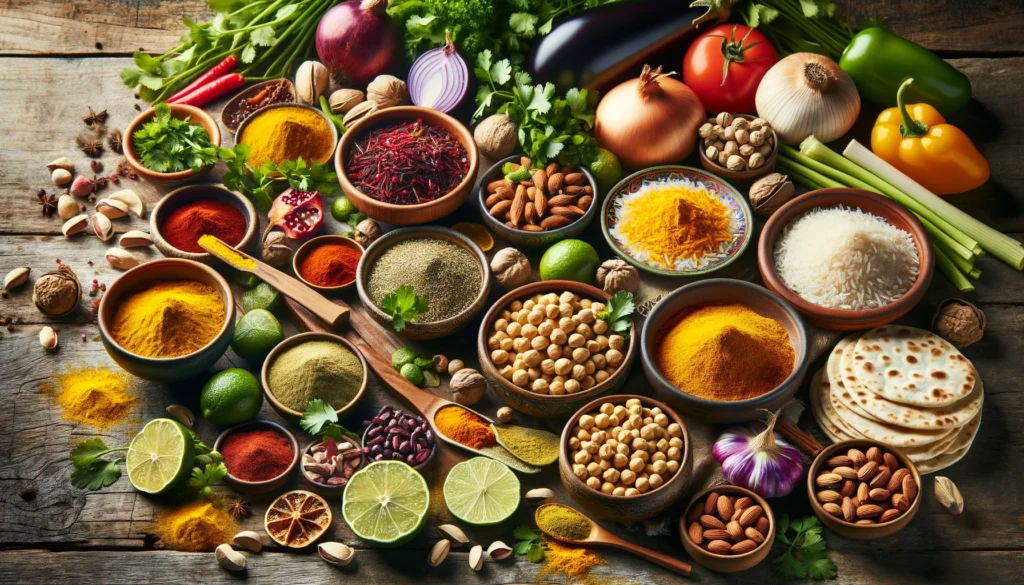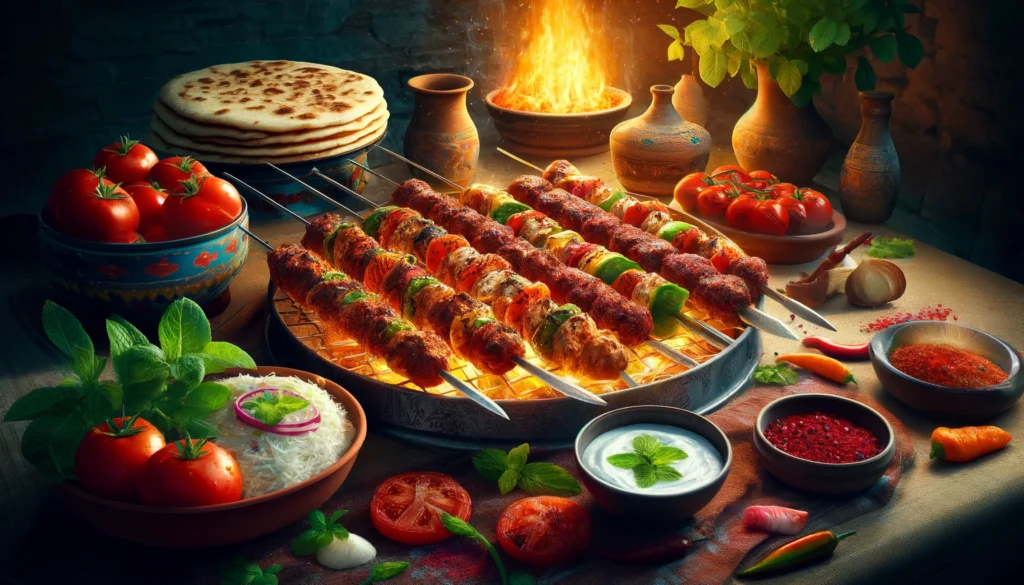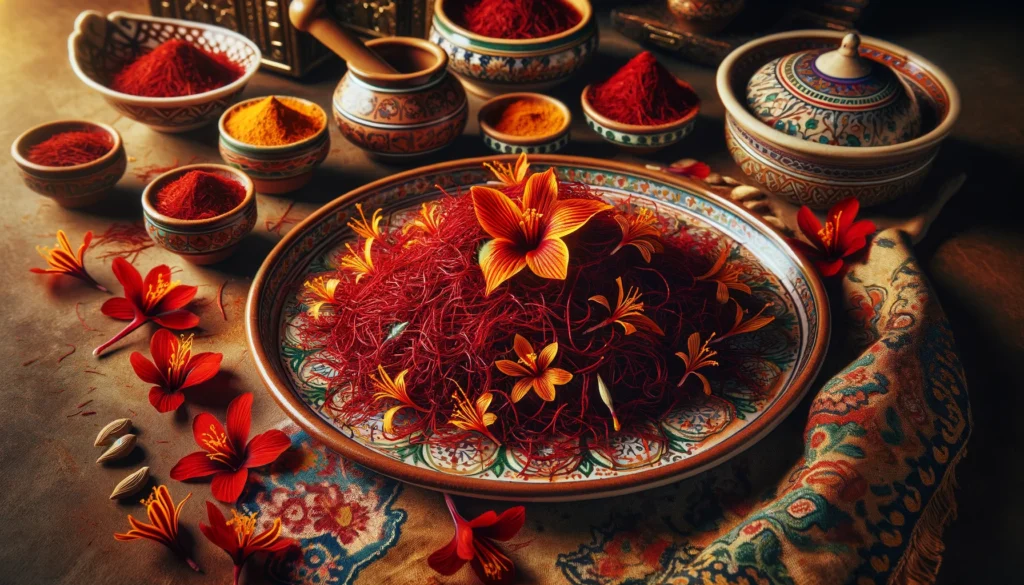Introduction
Persian food, also referred to as Iranian cuisine is a diverse array of flavours and textures that have been refined over the course of millennia. Influences from neighbouring Middle Eastern countries and a history that dates back to the beginning of Persia, Iranian cuisine offers the most unique and delicious dining experience. This article will guide you through the main points of Persian cuisine, with a focus on the most famous recipes and the ingredients.
Table of Contents
Overview of Persian Cuisine
Persian food is characterized by the utilization of freshly harvested herbs aromatic spice, as well as a balanced of textures and flavors. Its cuisine is a reflection of the diversity of Iran’s geography and historical roots and is a real culinary jewel within the Middle Eastern food landscape.
History and Evolution of Iranian Cuisine
Persian food :Iranian cuisine has developed over a period of hundreds of years, and has been it was influenced by the an ancient Persia as well as the surrounding regions and trade routes from the past. The use of various ingredients such as pomegranate, saffron, and herbs date from the beginning of time and remains integral to contemporary Persian cuisine.
Staple Ingredients in Persian Cooking

Basmati Rice
Basmati rice is the cornerstone of Persian cuisine. It is renowned for its large grains and aromatic properties. It is the basis for many of the traditional Persian dishes.
Saffron
Saffron is commonly known as”the “golden spice,” is sought-after for its distinctive flavor and vivid color. It can be used in sweet and savory dishes to give depth and depth and.
Pomegranate
Pomegranate is the symbol of rebirth and fertility within Persian culture. Its sweet seeds and tart taste are found in many recipes including stews, salads and soups.
Persian Herbs
Fresh herbs like cilantro, parsley mint, tarragon, and parsley are essential ingredients in Persian cooking which adds freshness and a sense of sophistication to dishes.
Traditional Persian Dishes
Kebabs: A Persian Grilling Tradition

Kebabs are an essential component of Persian food, with a variety of succulent beef and lamb skewers, to delicate fish and chicken varieties. They’re typically marinated with the combination of saffron, yogurt, and spices prior to grilling.
Stews and Soups: Rich and Flavorful
Persian stews (khoresht) and soups (ash) are renowned for their deep, rich flavor. Most popular stews include Ghormeh Sabzi (herb stew) and Fesenjan (pomegranate walnut stew).
Rice Dishes: The Heart of Persian Meals
Rice dishes like Chelo (plain rice), Polo (mixed rice) along with Tahchin (rice cakes) are the mainstays of Persian food. They are usually decorated with nuts, saffron or dried fruits.
Persian Kebabs: A Culinary Delight
Types of Kebabs

- Kabab Koobideh The ground beef or lamb blended with spices and onions.
- Jujeh Kabab: Pieces of chicken marinated, typically served with tomatoes grilled.
- Kabab Barg Lamb or beef that is thinly cut or beef Grilled and marinated to the perfect level.
Ingredients and Marinades
The most common marinades are yogurt, saffron and garlic, lemon juice and a blend of spices. The ingredients help to tenderize the meat and give it a tangy taste.
Cooking Techniques
Persian Kebabs are cooked on open flames, giving them a rich taste and charred outside. Grilling is an artform that requires expertise and a certain amount of precision.
The Art of Cooking Persian Rice
Types of Persian Rice Dishes
- Chelo: Simple, steamed basmati rice.
- Polo rice combined with herbs, vegetables or even meat.
- Tahchin Tahchin: A delicious rice cake that is often served with lamb or chicken.
The Role of Saffron
Saffron is usually infused with hot water prior to being drizzled over rice, giving it its distinct aroma and color.
Tahdig: The Golden Crust
Tahdig is the sought-after golden crust that is formed in the bottom of the rice cooker It is considered to be a delicacy and often the subject of debate at the table.
Saffron: The Golden Spice

History and Cultural Significance
Saffron is cultivated in Iran for more than three thousand years. It is integrated into Persian food and culture. Saffron is the symbol of elegance and hospitality.
Culinary Uses
Saffron is utilized in a variety of foods that range from stews and rice to desserts and drinks. Its distinctive flavor cannot be duplicated with any other flavor.
Health Benefits
Saffron is a well-known ingredient for its antioxidant qualities and potential health benefits. These include enhanced mood, memory and digestion.
Pomegranate: The Jewel of Persian Cuisine

Historical Background
Pomegranate is grown in Iran from the beginning of time and is a symbol of significant cultural and symbolic significance.
Culinary Applications
Pomegranate juice and seeds are utilized in stews, salads and desserts. Molasses from pomegranate is a major ingredient in the well-known Fesenjan stew.
Nutritional Value
Pomegranates are high in antioxidants, vitamins and minerals, which makes them an excellent food item to add to your daily diet.
Feta Cheese: A Persian Twist

Use in Persian Dishes
Feta cheese is typically served on salads, tossed with dips and served along with fresh herbs and bread.
Flavor Profile
Persian Feta is usually more creamy and mild in comparison to its Greek counterpart, providing distinctive flavor that pairs well with numerous dishes.
Popular Recipes
A few of the most popular recipes are Borani (yogurt as well as spinach and feta dip) Feta) along with Sabzi Khordan (a plate of freshly-cut herbs along with feta and nuts).
Yogurt Sauces: Creamy and Tangy

Types of Persian Yogurt Sauces
- Mast-o-Khiar Yogurt mingled with mint, cucumber, and occasionally raisins.
- Borani Yogurt mingled with cooked vegetables, such as eggplant or spinach.
Ingredients and Preparation
Persian yogurt sauces typically comprise fresh garlic, herbs as well as a hint of salt. They are usually served as a dish or a condiment.
Serving Suggestions
Yogurt sauces make great accompaniments to rice dishes, kebabs and grilled vegetables.
Persian Herbs: Fresh and Fragrant

Common Herbs Used in Persian Cooking
- Parsley
- Cilantro
- Dill
- Mint
- Tarragon
Health Benefits
They are stuffed with vitamins, minerals as well as antioxidants, which contribute to their health benefits.
Culinary Uses
Fresh herbs are often used in stews, salads, rice dishes, and also as garnishes. They add color and flavor to Persian cuisine.
Persian Desserts: Sweet Endings

Popular Persian Sweets
- Baklava Filo pastry layers as well as honey, nuts and.
- Saffron Ice Cream Ice cream that is creamy and flavored by rosewater and saffron.
- Faloodeh Faloodeh is a refreshing dish made of rice noodles, rose water as well as lime juice.
Ingredients and Recipes
Persian desserts typically contain ingredients like rosewater, saffron as well as almonds, pistachios and pistachios.
Cultural Significance
Desserts are an integral component of Persian celebrations and are usually served on special occasions or festivals.
Health Benefits of Persian Cuisine

Nutritional Profiles
Persian cuisine is balanced with a strong emphasis on fresh, healthy meats, vegetables and whole grain. The addition of spices and herbs adds the flavor as well as the nutritional value.
Traditional Cooking Methods
Traditional cooking techniques typically require slow cooking, grilling and simmering, that help preserve nutrients and increase flavor.
Health-Conscious Dishes
Many Persian dishes are health-conscious and naturally healthy like grilling kebabs, stews made with herbs as well as yogurt-based condiments.
Cultural Significance of Persian Food
Festivals and Celebrations
Food is a major part in Persian celebrations and festivals, like Nowruz (Persian New Year) which is when traditional Persian dishes are cooked and shared with family and acquaintances.
Influence on Persian Identity
Persian cuisine is an expression of the rich cultural heritage of Iran and plays a crucial part in defining the national sense of identity as well as pride.
Conclusion
Persian culinary tradition is a culinary journey that spans the centuries of history and cultural influences. From the fragrant saffron rice to the delicious kebabs and sweet desserts every dish is a smoky flavor of Iran’s rich past. No matter if you’re an experienced foodie or are new to Persian food, this dish promises a memorable, delicious experience.
FAQs
Is there a most loved dish that is served in Iran?
A very well-known dishes from Iran includes Chelo Kebab, consisting of cooked basmati rice, barbecued meat kebabs.
What are the most popular spices used in Persian cuisine?
Common spices include saffron cinnamon, turmeric and cardamom. These spices provide depth and flavor to Persian food items.
What makes Persian the food different than the other Middle Eastern cuisines?
Persian food is distinctive due to its focus in fresh and natural ingredients, distinctive flavors, and the widespread use of saffron and the pomegranate.
What is Tahdig? And what is its significance?
Tahdig is the crisp golden crust in the middle of a pot of rice is considered to be a delicacy and is often the star of an evening’s meal.
Are there vegetarian alternatives in Persian food?
Indeed, Persian cuisine offers a range of vegetarian meals, including rice, stews with herbs, dishes and salads.
